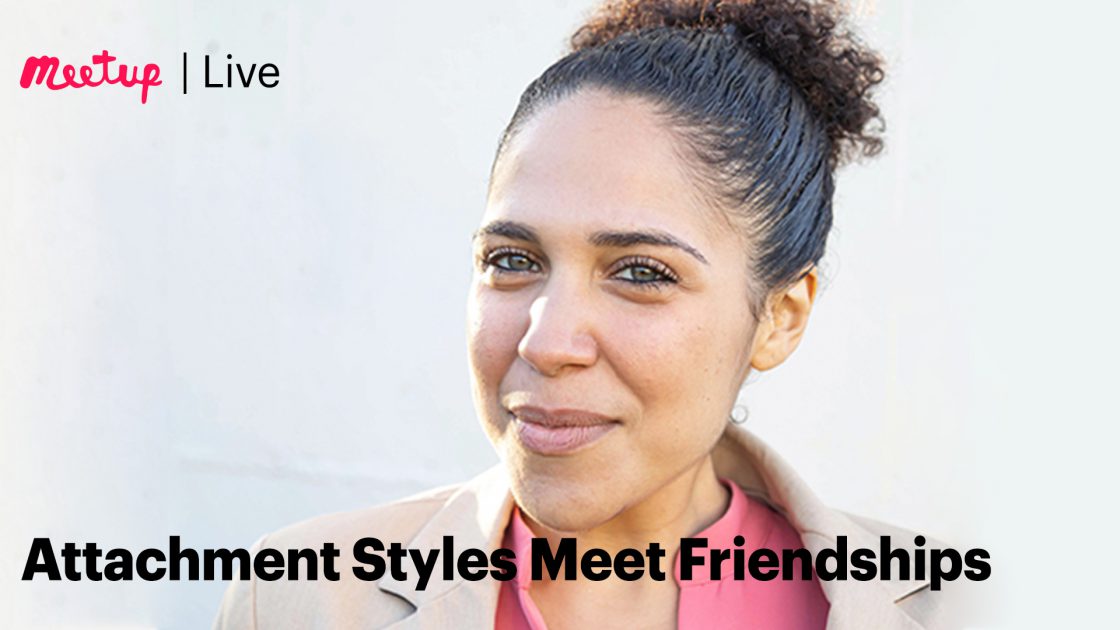“Make new friends but keep the old” is a classic line for a reason. Sustaining healthy friendships is a process that requires some effort and care. In this Meetup Live recording, we will be talking about how different attachment styles have an impact on a friendship’s longevity.
Marisa Franco, author of the New York Times bestseller Platonic: How The Science of Attachment Can Help You Make–and Keep–Friends as an Adult, will help us understand how attachment styles influence friendships. You will hear the secrets to forming and maintaining adult friendships, identify characteristics of good friendships, and learn what different attachment styles are and how they influence your friendships.
Main Takeaways:
Our attachment shapes how we interpret ambiguity. We can interpret very similar events differently based on our attachment style.
- Secure: Securely attached people assume people already like them. They’re comfortable being vulnerable, but they modulate their vulnerability based on the vulnerability of the other person, they’re quite flexible. They tend to be the most pro-social, which means they’re the more generous and the most empathic attachment style.
- Anxious: Anxiously attached folks try to make friendships move rapidly because their core fear is that they will be abandoned. They’re very concerned about how the other person is doing and less concerned about how they’re doing themselves. They tend to be attracted to relationships with people that pull away and when people pull away, they work harder to keep them. Whereas a secure person, if someone pulls away, they walk away too and find other people that actually do value them. Anxiously attached tend to ignore conflict and withdraw, whereas secure people will address conflict in their friendships.
- Avoidant: Avoidant attachment styles are thinking about their own needs and discomforts, rather than thinking about their impact on other people. Whereas anxiously attach people think too much about other people and not enough about themselves, securely attached people weigh the needs of everyone equally in a balanced way.
Your attachment style isn’t permanent, you can work towards changing your attachment style. Even learning the attachment theory, research finds, helps people change their attachment style.
Top Q&A Questions and Resources:
- How do you go from an anxious attachment style to a secure attachment?
- I shared some practices today such as assuming people like you. There is the heal framework where you savor experiences of social safety, and being friends with people that are more secure instead of trying to chase down people that aren’t as interested. If you’re anxiously attached, there’s this theory called “Internal Family System Theory,” It’s the idea that we have a family of people inside of us, and some of those people were created in reaction to traumatic experiences that we’ve been through. But we also have a “highest self,” and if you are able to access your highest self, there is a secure self inside. Take a moment when you’re in distress to locate your secure self and start treating yourself, internally, like a securely attached person. Visualize the secure side of you speaking to the anxious side of you, and be very loving towards it.
- How can I support an anxious person when they want more from me than I am comfortable giving?
- This person’s underlying need is reassurance that they are loved. They’re telling you how to do this in multiple ways. Some of their needs might be too much, they expect you to fulfill their needs even when that comes at a cost of your own needs. You can set a boundary in a loving way so that you are fulfilling their needs and it’s being expressed through the things they’re expecting but you are also able to set limitations. When you are unable to reach their expectations, you can say “I appreciate you, I wish I could be more helpful but I can’t at this time”. The boundary can be phrased in a gentle, loving way.
- Can you ever distinguish which side the issue in the friendship?
- Researcher Eli Finkle does this intervention with couples where you talk about the fight but you use your first names. This third-person activity gives you a more secure perspective. You’re able to think about your needs and the other person’s needs at the same time. This is going to give you some insight as to what’s going on in the dynamic. When we’re trying to perceive reality, and we’re part of that reality, we have the self-defense mechanism that kicks in and makes it really hard to predict things. You can take yourself out of the equation and try to think of the issue from the other perspective.
Resources:
- Purchase Platonic in the U.S. or the U.K.
- Take this quiz to assess your strengths and weaknesses as a friend
- Reach out for speaking engagements navigate here
- Follow for more friendship tips on Instagram
- Start a free trial of Meetup+, a subscription designed for sparking friendships.
Last modified on December 18, 2023












